Edward Haycock Sr.
| Edward Haycock | |
|---|---|
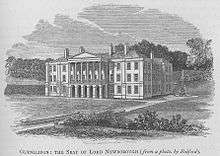 Glynllifon, Caernarfonshire. From Nicholls "Annals and Antiquities of Wales", 1872. Vol 1, 315 | |
| Born |
29 July 1790 Shrewsbury |
| Died |
20 December 1870 Shrewsbury |
| Nationality | British |
| Alma mater | A pupil of Sir Jeffrey Wyattville |
| Occupation | Architect |
| Practice | J H and E Haycock c1815-30 |
| Buildings | Millichope, Glynllifon and Clytha Park. |
| Projects | The planned town at Aberaeron, Ceredigion |
Edward Haycock Sr. (29 July 1790 – 20 December 1870) was an architect working in the West Midlands and in Central and Southern Wales in the late Georgian and early Victorian periods.[1]
Family and Social life
He was the grandson of William Haycock (1725–1802) of Shrewsbury and the son of John Hiram Haycock (1759–1830), who were architects and building contractors. Edward Haycock Senior joined the family business after 1810 and took control of the business after his father's death in 1830. He stopped working as a building contractor around 1845 and was joined by his son Edward Haycock Junior (1829/30-1882), who continued the architectural practice until about 1880.[2] He married Mary Hatton on 13 February 1827 at St Sepulchre-without-Newgate, London. By her she had three sons and four daughters.[3]
Haycock also played an active part in the political life of Shrewsbury as a Conservative: he sat on the council for thirty-four years, rose to become an alderman, and served as mayor in 1842.[4] He was a friend of the Shrewsbury architect John Carline and also of Dr Robert Waring Darwin, the father of the naturalist Charles Darwin.[3]
He died on 20 December 1870 at his home, The Priory, Shrewsbury,[5] aged 80[4] and was buried in St Chad's churchyard.[3]
"Haycock Way", linking Shrewsbury's 20th century inner ring road to the Column roundabout at Abbey Foregate, is named for the family.[6]
Architectural career

Edward Haycock received professional training in London under Sir Jeffrey Wyattville, exhibiting at the Royal Academy between 1808 and 1810. He then rejoined his father in the family building firm, working as builder and architect until about 1845, when he became a full-time architect. Work for the Gwynne family of Monachty led to the planning of Aberaeron. He was appointed County Surveyor of Shropshire from 1834 to 1866.
Haycock's Architectural Associations and Style
Haycock was a member of a group of architects, which included Thomas Farnolls Pritchard, Joseph Bromfield and John Carline, who established Shrewsbury as a major centre for architectural innovation in the later 18th and first half of the 19th century. This group gained many major architectural commissions in Shropshire and over much of Wales, despite competition from major London architects. Edward Haycock Snr specialised as a Gothic Revival architect.

His father had used the Ionic orders very effectively on the Shrewsbury Shirehall[7] and Edward Haycock continued with the use of Ionic orders on his major projects as at Millichope Park, Glynllifon and Clytha Park.[8] His churches tend to be more pedestrian, using a simplified Gothic, often with crocketed pinnacles on the towers. A departure from this is St Catherine's, Doddington, (a suburb of Whitchurch, Shropshire) 1836-7, which has an impressive Grecian revival facade.
Edward Haycock and the laying out of Aberaeron
%2C_Aberaeron_-_geograph.org.uk_-_592826.jpg)
Traditionally, it has been thought that the planning and layout of Aberaeron was by John Nash.[9] The town was founded following an Act of Parliament in 1807, but it appears that town did not start to be laid out until about 1830.[10] Edward Haycock was employed by Colonel A J Gwynne for supervising the building of houses and their layout in a grid plan around squares. In 1833, Samuel Lewis’s “Topographical Dictionary of Wales” records “Upwards of thirty new leases have been granted, pursuant to which several houses have been already built, and others are already in progress; a general post-office, a posting-house and an excellent hotel have been established". The Town Hall (1833–35), which later became the Cardiganshire County Hall, a typical building in Haycock’s style soon followed.[11] The building of planned town continued until the 1850s with a house in Alban Square dated 1855. The posting house mentioned by Lewis could be the Castle and the hotel could be the Harbourmaster Hotel. Haycock achieved a consistency of style throughout the project which results in the attractive appearance of Aberaeron today.
List of architectural work
Public Building and Monuments

- Shrewsbury 1814–16: Lord Hill's Column at Shrewsbury (assisted by Thomas Harrison of Chester[12]
- Shrewsbury, The Butter Market, Pride Hill, 1819–20, demolished 1830 – New Butter Market[12]
- Dolgellau, Merionethshire, The County Hall, 1823-5[12]
- Coed-Cwnwr Almshouses, Monmouthshire, 1825[12]
- Presteigne, The Radnorshire Town Hall 1826-9[12][13]
- Shrewsbury, The Salop Infirmary,[12] rebuild 1827–30[14]
- Monmouth, Shirehall[12]
- Cardiff, The Market[12]
- Neath Market, 1835-6[12]
- Shrewsbury Savings Bank[12]
- Shrewsbury The Music Hall, 1839–40[12]
- Wrockwardine Almshouses[12]
- Dowlais Market Hall[12]
- Llandovery National School[12]
- Llandeilo Bridge, 1848[12]
- Shrewsbury Lancastrian School[12]
- Shrewsbury St Chad's School, 1859[12]
- Bicton Heath Shropshire County Lunatic Asylum alterations[15]
A newspaper obituary states Haycock also "obtained first prizes for plans for the Birmingham and New Orleans Infirmaries"[16] but these are not mentioned by Colvin.
Churches
Shropshire
- Shrewsbury St George, Frankwell 1829–32
- Tilstock 1835
- Whitchurch, St Catherine, Doddington. 1836-7
- Cruckton 1840
- Cressage 1841
- Cound 1842-3
- Bayston Hill 1843
- Clun Chapel Lawn 1843
- Hope 1843
- Middleton in Chirbury 1843
- Dorrington 1843-5
- Newcastle 1848
- Church Pulverbatch 1852-3
- Christ Church Shelton and Oxon 1854
Staffordshire
- Tettenhall 1825
Breconshire
- Hay on Wye 1833-4
Cardiganshire
- Aberaeron 1835
Carmarthenshire
- Carmarthen St David.
- Llannon 1841
Ceredigion
- Aberaeron
- Aberystwyth St Michael 1830-3
- St David's Church, Barmouth 1830
Glamorgan
- Caerphilly 1826
- Tai Bach Margam 1827
Merioneth
- Barmouth 1830
Monmouthshire
- Abersychan 1831-2
- Trevethin St Thomas 1831-2
- Lanvaud 1843
Montgomeryshire
- Machynlleth 1827
Country Houses
Shropshire
- Onslow Hall 1815–20 – Remodelled house for John Wingfield[15]
- Loton Park – Reconstructed south front 1819.[15]
- Hodnet Rectory. For Rev Reginald Heber. Presumably a joint design with his father.[15]
- Stanton Lacy Downton Hall near Ludlow. 1824 – New front entrance[17]
- Clungunford House.1825-8. For the Rev John Rocke.[15]
- Orleton Hall. Refronted house c1830.[15]
- Walford Manor 1831-5.[18]
- Leaton Knolls. c1835. Demolished 1955.[15]
- Millichope Park, Shropshire 1835–40, Greek Revival house for Rev. R.N. Pemberton.[18]
- Longner Hall. Alterations 1838–42.[18][19]
- Condover Vicarage 1843. Tudorish.[18]
- Badger Hall. Alterations 1849–50.[18]
- Netley Hall, Shropshire.1854-8.[18]
- Stanton Lacy Vicarage.[15]
Herefordshire
Northamptonshire
Caernarfonshire
- Glynllifon 1836–49. For Lord Newborough.[18]
Caermarthenshire
- Stradey Castle 1849–53.[18]
Cardiganshire
- Llansantffraerd Alltlwyd House 1832.[18]
- Plas Llangoedmor, Rebuilt 1833.[18]
- Monordeifi (Manordeifi), Clynfyw c1849-50 (now Pembrokeshire).[18]
- Llandygwydd Penlyan. 1852.[18]
Ceredigion
- Nanteos Portico, new dining room and new frontage to Stable block c1839-49. The original stable block appear to have been built to designs by John Nash of c1813-5.[18]
Glamorgan
- Penrice Castle Minor Works.[18]
- Swansea Penllergare. 1836. Demolished except for a lodge and observatory.[18]
- Sketty Hall −1830s Entrance hall[20]
Montgomeryshire
- Welshpool Rectory
- Churchstoke Vicarage. Enlarged 1846-7.[15]
Monmouthshire
- Clytha Park 1824–28 – House for William Jones
Radnorshire
- Stanage Park. Alterations 1845.[18]
Literature
- Colvin H. (2008) A Biographical Dictionary of British Architects 1600–1840. Yale University Press, 4th edition London.
- Lloyd T et al.(2006):Carmarthenshire and Ceredigion: The Buildings of Wales, Yale University Press.
- J Newman and N Pevsner, (2006), The Buildings of England: Shropshire, Yale.
- R Scourfield and R Haslam (2013, The Buildings of Wales: Powys; Montgomeryshire, Radnorshire and Breconshire, Yale University Press.
References
- ↑ Colvin H. A Biographical Dictionary of British Architects 1600–1840 Yale University Press, 3rd edition London, 1995, 478–481. The 4th edition, published in 2008 may contain further information.
- ↑ Antonia Brodie (ed) Directory of British Architects, 1834–1914: 2 Vols, British Architectural Library, Royal Institute of British Architects, 2001, 871–2.
- 1 2 3 Peter Leach, 'Haycock, Edward (bap. 1790, d. 1870)', rev. Oxford Dictionary of National Biography, Oxford University Press, 2004 He was mayor of Shrewsbury in 1842. http://www.oxforddnb.com/templates/article.jsp?articleid=37523&back=
- 1 2 J. L. Hobbs, 'The Haycocks', Shropshire Magazine, 11 (Feb 1960), 17–18
- ↑ "Deaths (notices)". The Shrewsbury Chronicle. 23 December 1870. p. 5.
- ↑ Shrewsbury Local History website. The page features a photograph of Edward Sr.
- ↑ http://shrewsburylocalhistory.org.uk/haycock.htm
- ↑ J Mordaunt Crook 'The Greek Revival: Neoclassical Attitudes in British Architecture 1760–1870 John Murray 1972, 98& 102, Pls 98, 122 &135
- ↑ Hilling J B "The Historic Architecture of Wales: An Introduction” Univ. Wales Press,1976, 150, fig 91
- ↑ H.V. Pythian Adams “The Planning of Aberaeron”, Ceredigion, viii, 1979, 406–7
- ↑ Lloyd T et al.:"Carmarthenshire and Ceredigion: The Buildings of Wales", Yale University Press 2006, 394
- 1 2 3 4 5 6 7 8 9 10 11 12 13 14 15 16 17 "Colvin" 3rd edition, 479
- ↑ R Scourfield and R Haslam "The Buildings of Wales: Powys; Montgomeryshire, Radnorshire and Breconshire" Yale University Press 2013, 398
- ↑ Keeling-Roberts, Margaret (1981). In Retrospect, A Short History of The Royal Salop Infirmary. North Shropshire Printing Company. pp. 26–27.The completion stone of the rebuild names the architect as "Edward Haycocks" (sic).
- 1 2 3 4 5 6 7 8 9 10 "Colvin" 3rd edition, 480
- ↑ "The Late Edward Haycock, Esq.". Eddowes's Shrewsbury Journal. 28 December 1870. p. 5.The latter being Touro Infirmary, founded 1852.
- ↑ "Newman and Pevsner" 251
- 1 2 3 4 5 6 7 8 9 10 11 12 13 14 15 16 17 18 19 "Colvin" 3rd edition, 481
- ↑ J Newman and N Pevsner "The Buildings of England: Shropshire”, Yale 2006344-5
- ↑ "Sketty Hall-A Place in Local History". Retrieved 4 July 2013.
External links
| Wikimedia Commons has media related to Edward Haycock, Sr.. |
- Edward Haycock, Sr. The Dicamillo Companion accessed = 2 May 2013 http://www.dicamillocompanion.com/Architect_Detail.asp?ID=2393| title=|
- Edward Haycock Oxfordartonline|accessdate= 2 May 2013 Subscription required http://www.oxfordartonline.com/subscriber/article/grove/art/T037033|title
Gallery of architectural work
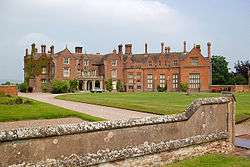 Loton Park
Loton Park Clytha Park
Clytha Park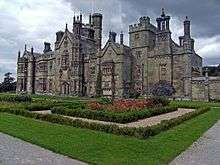
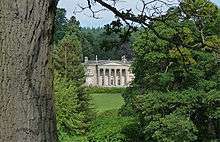 Millichope Park, Munslow
Millichope Park, Munslow The Grand Lodge at Glynllifon from the Park
The Grand Lodge at Glynllifon from the Park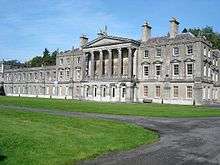 Glynllifon
Glynllifon
- Stable Block Nanteos Ceredigion
 Former Royal Salop Infirmary
Former Royal Salop Infirmary Former Royal Salop Infirmary, now Parade Shopping Centre, St Mary's Place, Shrewsbury
Former Royal Salop Infirmary, now Parade Shopping Centre, St Mary's Place, Shrewsbury The Music Hall, Shrewsbury
The Music Hall, Shrewsbury.jpg) Presteigne Town Hall,(centre) Broad Street, Presteigne
Presteigne Town Hall,(centre) Broad Street, Presteigne Dolgellau County Hall.
Dolgellau County Hall.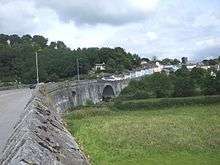 Bridge over the Tywi at Llandeilo
Bridge over the Tywi at Llandeilo Regent Street, Aberaeron
Regent Street, Aberaeron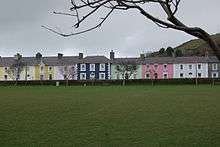 Alban Square, Aberaeron
Alban Square, Aberaeron.jpg) 7 Portland Place
7 Portland Place Doric pedimented doorway, Quay Parade, Aberaeron
Doric pedimented doorway, Quay Parade, Aberaeron Back of Music Hall, College Hill, Shrewsbury
Back of Music Hall, College Hill, Shrewsbury St. George's Church, Frankwell, Shrewsbury.
St. George's Church, Frankwell, Shrewsbury. Church tower, Dorrington
Church tower, Dorrington St Peters, t Machynlleth. Largely re-built 1827
St Peters, t Machynlleth. Largely re-built 1827 St Mary's church, Clun Chapel Lawn
St Mary's church, Clun Chapel Lawn Aberaeron Church Largely rebuilt but pinnacled tower is typical of Haycock
Aberaeron Church Largely rebuilt but pinnacled tower is typical of Haycock Holy Trinity Church, Aberaeron
Holy Trinity Church, Aberaeron